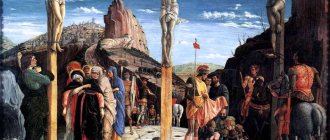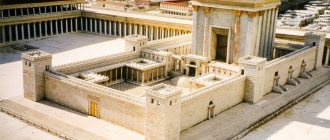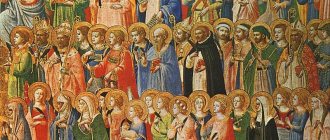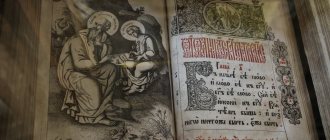| Attention! This article contains an incomplete, one-sided or biased description, but its subject matter should be covered in the Tradition. You can help the Project by rewriting it in an encyclopedic style. Thank you. |
Canonization of the royal family
— canonization by the Russian Orthodox Church of the last Emperor Nicholas II and members of his family, one of the most controversial acts of the Russian Orthodox Church in its entire history, which caused an extremely negative reaction from a significant part of Orthodox believers, including such prominent figures of the Russian Orthodox Church as Metropolitan John of St. Petersburg and Ladoga, A.I. Osipov and others. Nicholas II and members of his family were glorified as passion-bearers. At the same time, the servants who were shot along with the royal family were not canonized.
History of glorification
In 1928, Nicholas II and his family were canonized as saints of the Catacomb Church.
In 1981, the emperor and his family were glorified by a group of bishops “who call themselves the Council of Bishops of the Russian Orthodox Church Abroad, which does not have the recognition of the entire Orthodox Plenitude due to its anti-canonical nature” (From the appeal of the Council of Bishops of the Russian Orthodox Church, 1990), in other words the so-called. Russian Church Abroad.
In the last decade of the 20th century in Russia, a number of clergy who sympathized with the so-called. The “Russian Church Abroad” launched a campaign for the canonization of the now Russian Orthodox Church of the emperor and his family, as well as servants. Many prominent representatives of the Russian Orthodox Church spoke out against canonization, including Metropolitan John (Snychev) of St. Petersburg and Ladoga. As a result, the Council of Bishops in 1997 refused to canonize the former sovereign. According to one of the prominent opponents of the canonization of Nicholas II, professor of the Moscow Theological Academy A.I. Osipov, the moral character and scale of the personality of Nicholas II in no way corresponded to those of the general church holy ascetics.
However, pressure on the Russian Orthodox Church from supporters of canonization increased. In radical monarchist and pseudo-Orthodox circles, even the epithet “redeemer” is used in relation to Nicholas II. This is manifested both in written appeals sent to the Moscow Patriarchate when considering the issue of canonization of the royal family, and in non-canonical akathists and prayers: “O most wonderful and glorious Tsar-Redeemer Nicholas.” However, at a meeting of the Moscow clergy, Patriarch Alexy II unequivocally spoke out about the inadmissibility of this, saying that “if he sees in some church books in which Nicholas II is called the Redeemer, he will consider the rector of this temple as a preacher of heresy. We have one Redeemer - Christ."
In accordance with the next decision of the Council of Bishops of the Russian Orthodox Church dated August 20, 2000, Nicholas II, Tsarina Alexandra Feodorovna, Tsarevich Alexei, princesses Olga, Tatiana, Maria, Anastasia were canonized as holy new martyrs and confessors of Russia, revealed and unmanifested.
Memorial Day: July 4 (17) (1918)
Opponents of canonization
Such a long, complex decision-making process regarding the Royal Family is quite understandable - the Tsar’s persona was too ambiguous during the troubled revolutionary years. The synodal commission had a difficult task - to separate the spiritual achievements of Nicholas II, his desire to fulfill God's Commandments from political activities.
Of course, the personality of the anointed king is closely intertwined with his activities in the sphere of government. And the fact that with the beginning of the revolution there was a formal renunciation of the throne does not add positive assessments to Nicholas II. And it was this fact that became the object of the greatest controversy and the emergence of zealous opponents of canonization.
In addition to abdication, the last Russian emperor is accused of cruelty towards the victims of the First World War. According to some eyewitnesses, Nicholas II allowed himself statements that showed obvious disregard for the large number of deaths.
For those who opposed canonizing the Tsar, an important argument was that the Tsar was considered a cruel hunter. There is an opinion that in addition to hunting wild animals, Nicholas II could exterminate cats and dogs.
Many historians argue that Nicholas II cannot be called a wise and outstanding politician and ruler. Multiple armed uprisings and unsuccessful government policies led to the fact that it was during the reign of Nicholas II that Tsarist Russia fell.
Tomb of the Romanov family in the Peter and Paul Cathedral
There was also a widespread opinion that the canonization of the Tsar was a kind of political farce aimed at the dubious glorification of Tsarist Russia. Supporters of this approach believe that the face of the sovereign’s holiness makes it possible to implausibly embellish the period of monarchical power in Russia.
Arguments against canonization
- The death of Emperor Nicholas II and members of his family was not a martyrdom for Christ, but only political repression.
- The emperor's unsuccessful state and church policies, including such events as Khodynka, Bloody Sunday and the Lena shooting.
- The extremely controversial activities of Grigory Rasputin.
- The abdication of the anointed king from the throne should be considered as a church-canonical crime, similar to the refusal of a representative of the church hierarchy from the priesthood.
- “The religiosity of the royal couple, for all its outwardly traditional Orthodoxy, bore a clearly expressed character of interconfessional mysticism.”
- The active movement for the canonization of the royal family in the 1990s was not spiritual, but political.
- MDA Professor A.I. Osipov: “Neither the holy Patriarch Tikhon, nor the holy Metropolitan of Petrograd Benjamin, nor the holy Metropolitan Peter of Krutitsky, nor the holy Metropolitan Seraphim (Chichagov), nor the holy Archbishop Thaddeus, nor the holy Archbishop Hilarion (Troitsky), who, without doubts, he will soon be canonized, neither the other hierarchs now glorified by our Church, the new martyrs, who knew much more and better than we now, the personality of the former Tsar - none of them ever expressed thoughts about him as a holy passion-bearer (and in At that time it was still possible to declare this loudly).”
- The responsibility for “the gravest sin of regicide, which weighs on all the peoples of Russia,” is also deeply bewildering, promoted by some supporters of canonization.
About the death of the last king
According to historical data, the last Emperor Nicholas II during the revolution was arrested and shot in the basement of the Ipatiev House in Yekaterinburg on the night of June 16-17, 1918. Four servants and associates were executed along with the sovereign's family.
Interesting! After a while, one of the Emperor’s close associates, who died with him in the Ipatiev House, will also be canonized. We are talking about the doctor Evgeniy Botkin.
The tsar's family itself consisted of seven people: Emperor Nikolai Romanov, Tsarina Alexandra Feodorovna and their five children - son Alexei and daughters Anastasia, Olga, Maria, Tatyana. At the time of the execution, the Tsar himself was 50 years old, his wife was 46, and the children were from 13 to 22 years old.
Family of Emperor Nicholas II
The news of the bloody massacre of the entire imperial family very quickly spread among the people. Almost immediately after the execution, sentiments began to emerge, which later strengthened and led to the canonization of Nicholas II.
Thus, Patriarch Tikhon himself, at the service closest to him after the shooting, said in his sermon that the whole Church mourns what happened. The Patriarch drew attention to the fact that Nicholas II and his entire family could go abroad, where they could ensure a calm and safe life for themselves. But he did not do this, but “remained to suffer together with Russia.” The Primate of the Church blessed all clergy to regularly hold services to commemorate the murdered.
Important! It is the fact that Nicholas II did not flee after his formal abdication of the throne that speaks of his sincere and genuine love for his Motherland.
The people's veneration of the Royal Family as martyrs gradually increased. It should be noted that canonically the last king and his relatives cannot be considered Christian martyrs, since their execution was not associated with the need to renounce their faith. In other words, no one demanded that they renounce Christ, and even if we assume that they would have done this, the death sentence would not have been canceled. That is why later the Royal Family will be canonized not as martyrs, but as passion-bearers.
The common people did not really understand the intricacies of church canons, so the king was revered as a martyr. Often a photograph of the entire murdered Royal Family was located next to the icons, in the home iconostasis. Of course, in those years the question of official canonization could not be raised, but veneration among the people was constantly increasing.
Icon of the Holy Royal Passion-Bearers
The Royal Family gained special veneration among emigrants and parishioners of the Orthodox Church Abroad. Many who, due to the political situation, were forced to leave their homeland, loved the emperor very much and worshiped him. After the violent death, this attitude only intensified.
Arguments for canonization in a different guise
The Jews are satisfied that the Royal Romanov family has been elevated to the ranks of passion-bearers, not martyrs, please note, but passion-bearers. What is the difference? The rite of martyrdom is the feat of death for Christ at the hands of non-believers. Passion-bearers are those who have suffered torment at the hands of their fellow Christians. According to the passion-bearing rite of canonization, it turns out that the Tsar and his Family were martyred by their own fellow Christians. Now, if the Council of Bishops had recognized the obvious, that the Tsar was tortured to death by the Gentiles, the Jews, then he would not have been a passion-bearer, but a great martyr. This is what the Jews are satisfied with, this is what they mean when they present an ultimatum to the Moscow Patriarchate: “It is very important that the decision on canonization in the form in which it was adopted by the Council becomes known to the widest circle of laity and clergy.”[1]
The collapse of autocracy - the execution of the Royal Family
In 1917, the monarchy in Russia was steadily moving toward decline. The February Revolution thundered, power passed to the Provisional Government, riots raged in Petrograd, and part of the garrisons rebelled. On the night of March 15-16, the emperor, instigated by front commanders and his own brother, signed the Act of Abdication for himself and his son . So the Romanov dynasty lost all hope of returning the previous regime.
On March 22, Nicholas II, his wife and children were arrested and imprisoned in the Alexander Palace of Tsarskoe Selo. On August 14, fearing that the White Guards would help them escape, the former ruler with his relatives and several servants was sent to Tobolsk, and at the end of April 1918 they were deported to Yekaterinburg. There they were settled in the “House of Special Purpose” - an estate requisitioned from engineer N. N. Ipatiev. The guards insulted and regularly searched the prisoners, stole their food and personal belongings, and staged provocations. The Royal Family spent 78 days in this mansion, the last refuge of the Romanovs. On July 16, 1918, the Ural Regional Council of Workers, Peasants and Red Army Deputies decided to execute the abdicated emperor along with his relatives and retinue - a physician, a chamberlain, a cook and a maid.
| The Romanov royal family (photo before death) Photo reconstruction | The room where the royal family was shot |
The sentence was carried out the very next night, July 17. Those arrested were taken to the basement, the verdict was read out, and indiscriminate shooting immediately began. The surviving princesses (they were protected by jewelry hidden in their corsets) and Alexei were finished off with bayonets. They even killed the dogs that belonged to the Romanovs. When the Royal Family was shot, they tried to bury the corpses in an old mine, throwing grenades at them, but then they took them out, doused them with sulfuric acid and burned them, and threw the remains into a swamp and piled them on top with sleepers.
GROUNDS FOR THE CANONIZATION OF THE ROYAL FAMILY
FROM THE REPORT OF METROPOLITAN JUVENALIY OF KRUTITSKY AND KOLOMENSKY, CHAIRMAN OF THE SYNODAL COMMISSION FOR THE CANONIZATION OF SAINTS By the
definition of the Council of Bishops from March 31 - April 4, 1992, the Synodal Commission for the Canonization of Saints was entrusted “with the study of the exploits of the new martyrs of Russia them to begin researching materials related to the martyrdom the death of the Royal Family."
The Commission saw the main task in this matter as an objective consideration of all the circumstances of the lives of members of the Imperial Family in the context of historical events and their ecclesiastical understanding outside the ideological stereotypes that have dominated our country over the past decades. The commission was guided by pastoral concern so that the canonization of the Royal Family in the host of Russian new martyrs would not provide a reason or argument for political struggle or worldly confrontations, but would contribute to the unification of the people of God in faith and piety. We also sought to take into account the fact of the canonization of the Royal Family by the Russian Church Abroad in 1981, which caused a far from unambiguous reaction both among the Russian emigration, some representatives of which did not then see enough convincing grounds in it, and in Russia itself, not to mention such which has no historical analogies in the Orthodox Church, the decision of the Russian Orthodox Church Outside of Russia, such as the inclusion of the Roman Catholic Roman Catholic servant Aloysius Yegorovich Trupp and the Lutheran goflektress Ekaterina Adolfovna Schneider among the canonized who accepted the martyrdom of the royal servant with the Royal Family.
Already at the first meeting of the Commission after the Council, we began to study the religious, moral and state aspects of the reign of the last Emperor of the Romanov dynasty. The following topics were carefully studied: “The Orthodox view of the state activities of Emperor Nicholas II”; “Emperor Nicholas II and the events of 1905 in St. Petersburg”; “On the church policy of Emperor Nicholas II”; “The reasons for the abdication of Emperor Nicholas II from the throne and the Orthodox attitude to this act”; “The Royal Family and G.E. Rasputin"; “The Last Days of the Royal Family” and “The Church’s Attitude to Passion-Bearing.”
In 1994 and 1997, I introduced the members of the Councils of Bishops to the results of the study of the above topics. Since that time, no new problems have appeared in the issue under study.
Let me remind you of the Commission’s approaches to these key and complex topics, the understanding of which is necessary for the members of the Council of Bishops when deciding the issue of canonization of the Royal Family.
The arguments of opponents of the canonization of the Royal Family, which are very different in religious and moral content and level of scientific competence, can be reduced to a list of specific theses that have already been analyzed in historical references compiled by the Commission and at your disposal.
One of the main arguments of opponents of the canonization of the Royal Family is the assertion that the death of Emperor Nicholas II and members of his Family cannot be recognized as a martyr’s death for Christ. The commission, based on a careful consideration of the circumstances of the death of the Royal Family, proposes to carry out its canonization as holy passion-bearers. In the liturgical and hagiographic literature of the Russian Orthodox Church, the word “passion-bearer” began to be used in relation to those Russian saints who, imitating Christ, patiently endured physical, moral suffering and death at the hands of political opponents.
In the history of the Russian Church, such passion-bearers were the holy noble princes Boris and Gleb (+1015), Igor Chernigovsky (+1147), Andrei Bogolyubsky (+1174), Mikhail Tverskoy (+1319), Tsarevich Dimitri (+1591). All of them, with their feat of passion-bearers, showed a high example of Christian morality and patience.
Opponents of this canonization are trying to find obstacles to the glorification of Nicholas II in facts related to his state and church policies.
The Emperor's church policy did not go beyond the traditional synodal system of governing the Church. However, it was during the reign of Emperor Nicholas II that the church hierarchy, which had until then been officially silent for two centuries on the issue of convening a Council, had the opportunity not only to widely discuss, but also to practically prepare for the convening of a Local Council.
The Emperor paid great attention to the needs of the Orthodox Church and generously donated for the construction of new churches, including outside Russia. During the years of his reign, the number of parish churches in Russia increased by more than 10 thousand, and more than 250 new monasteries were opened. The emperor personally participated in the laying of new temples and other church celebrations.
Their deep religiosity distinguished the Imperial couple from the representatives of the then aristocracy. The education of the children of the Imperial Family was imbued with a religious spirit. All its members lived in accordance with the traditions of Orthodox piety. Mandatory attendance at services on Sundays and holidays, and fasting during fasting were an integral part of their life. The personal religiosity of the Tsar and his wife was not a simple adherence to traditions. The royal couple visits churches and monasteries during their numerous trips, venerates miraculous icons and relics of saints, and makes pilgrimages, as was the case in 1903 during the glorification of St. Seraphim of Sarov. Brief services in court churches did not satisfy the Emperor and Empress. Services are held especially for them in the Tsarskoye Selo Feodorovsky Cathedral, built in the Old Russian style. Empress Alexandra prayed here in front of a lectern with open liturgical books, carefully watching the service.
The personal piety of the Sovereign was manifested in the fact that during the years of his reign more saints were canonized than in the two previous centuries, when only 5 saints were glorified. During the last reign, St. Theodosius of Chernigov (1896), St. Seraphim of Sarov (1903), Holy Princess Anna Kashinskaya (restoration of veneration in 1909), St. Joasaph of Belgorod (1911), St. Hermogenes of Moscow (1913), Saint Pitirim of Tambov (1914), Saint John of Tobolsk (1916). At the same time, the Emperor was forced to show special persistence, seeking the canonization of St. Seraphim of Sarov, Saints Joasaph of Belgorod and John of Tobolsk. Nicholas II highly revered the holy righteous father John of Kronstadt. After his blessed death, the king ordered a nationwide prayerful commemoration of the deceased on the day of his repose.
As a politician and statesman, the Emperor acted based on his religious and moral principles. One of the most common arguments against the canonization of Emperor Nicholas II are the events of January 9, 1905 in St. Petersburg. In the historical information of the Commission on this issue, we indicate: having become acquainted on the evening of January 8 with the contents of Gapon’s petition, which had the nature of a revolutionary ultimatum, which did not allow entering into constructive negotiations with representatives of the workers, the Sovereign ignored this document, illegal in form and undermining the prestige of the already wavering in the conditions wars of state power. Throughout January 9, 1905, the Sovereign did not make a single decision that determined the actions of the authorities in St. Petersburg to suppress mass protests by workers. The order for the troops to open fire was given not by the Emperor, but by the Commander of the St. Petersburg Military District. Historical data does not allow us to detect in the actions of the Sovereign in the January days of 1905 a conscious evil will directed against the people and embodied in specific sinful decisions and actions.
Since the beginning of the First World War, the Tsar regularly travels to Headquarters, visiting military units of the active army, dressing stations, military hospitals, rear factories, in a word, everything that played a role in the conduct of this war.
From the very beginning of the war, the Empress devoted herself to the wounded. Having completed nursing courses together with her eldest daughters, Grand Duchesses Olga and Tatiana, she spent several hours a day caring for the wounded in the Tsarskoye Selo infirmary.
The Emperor viewed his tenure as Supreme Commander-in-Chief as the fulfillment of a moral and national duty to God and the people, however, always presenting leading military specialists with a broad initiative in resolving the entire range of military-strategic and operational-tactical issues.
Assessments of Nicholas II as a statesman are extremely contradictory. Speaking about this, we should never forget that, when comprehending state activity from a Christian point of view, we must evaluate not this or that form of state structure, but the place that a specific person occupies in the state mechanism. The extent to which a person was able to embody Christian ideals in his activities is subject to assessment. It should be noted that Nicholas II treated the duties of the monarch as his sacred duty.
The desire, characteristic of some opponents of the canonization of Emperor Nicholas II, to present his abdication of the Throne as a church-canonical crime, similar to the refusal of a representative of the church hierarchy from the priesthood, cannot be recognized as having any serious grounds. The canonical status of the Orthodox sovereign anointed to the Kingdom was not defined in the church canons. Therefore, attempts to discover the elements of a certain church-canonical crime in the abdication of Emperor Nicholas II from power seem untenable.
As external factors that brought to life the Act of Abdication, which took place in the political life of Russia, we should highlight, first of all, the sharp aggravation of the socio-political situation in Petrograd in February 1917, the inability of the government to control the situation in the capital, which spread throughout wide sections of society conviction in the need for strict constitutional restrictions on monarchical power, the urgent demand of the Chairman of the State Duma M.V. Rodzianko, the abdication of Emperor Nicholas II from power in the name of preventing internal political chaos in the conditions of Russia's large-scale war, the almost unanimous support provided by the highest representatives of the Russian generals to the demand of the Chairman of the State Duma. It should also be noted that the Act of Abdication was adopted by Emperor Nicholas II under the pressure of dramatically changing political circumstances in an extremely short time.
The Commission expresses the opinion that the very fact of the abdication of the Throne of Emperor Nicholas II, which is directly related to his personal qualities, is generally an expression of the then historical situation in Russia.
He made this decision only in the hope that those who wanted to remove him would still be able to continue the war with honor and would not ruin the cause of saving Russia. He was afraid then that his refusal to sign the renunciation would lead to civil war in the sight of the enemy. The Tsar did not want even a drop of Russian blood to be shed because of him.
The spiritual motives for which the last Russian Sovereign, who did not want to shed the blood of his subjects, decided to abdicate the Throne in the name of internal peace in Russia, give his action a truly moral character. It is no coincidence that during the discussion in July 1918 at the Council of the Local Council of the question of the funeral commemoration of the murdered Sovereign, His Holiness Patriarch Tikhon made a decision on the widespread service of memorial services with the commemoration of Nicholas II as Emperor.
A very small circle of people could directly communicate with the Sovereign in an informal setting. Everyone who knew his family life first-hand noted the amazing simplicity, mutual love and harmony of all members of this closely knit Family. Its center was Alexey Nikolaevich, all attachments, all hopes were focused on him.
A circumstance that darkened the life of the Imperial Family was the incurable illness of the Heir. Attacks of hemophilia, during which the child experienced severe suffering, were repeated several times. In September 1912, as a result of a careless movement, internal bleeding occurred and the situation was so serious that they feared for the life of the Tsarevich. Prayers for his recovery were served in all churches in Russia. The nature of the illness was a state secret, and parents often had to hide their feelings while participating in the usual routine of palace life. The Empress understood well that medicine was powerless here. But nothing is impossible for God. Being deeply religious, she devoted herself wholeheartedly to fervent prayer in the hope of a miraculous healing. Sometimes, when the child was healthy, it seemed to her that her prayer had been answered, but the attacks were repeated again, and this filled the mother’s soul with endless sorrow. She was ready to believe anyone who was able to help her grief, to somehow alleviate her son’s suffering.
The illness of the Tsarevich opened the doors to the palace to the peasant Grigory Rasputin, who was destined to play his role in the life of the Royal Family, and in the fate of the entire country. The most significant argument among opponents of the canonization of the Royal Family is the very fact of their communication with G.E. Rasputin.
The relationship between the Emperor and Rasputin was complex; disposition towards him was combined with caution and doubts. “The Emperor tried several times to get rid of the “old man,” but each time he retreated under pressure from the Empress because of the need for Rasputin’s help to heal the Heir.”
In the relationship with Rasputin, there was an element of human frailty, associated in the Empress with a deep feeling of the incurability of her son’s deadly illness, and in the Emperor it was due to the desire to maintain peace in the Family through compassionate compliance with the maternal torment of the Empress. However, there is no reason to see in the relations of the Royal Family with Rasputin signs of spiritual delusion, and even more so of insufficient church involvement.
Summing up the study of the state and church activities of the last Russian Emperor, the Commission did not find in this activity alone sufficient grounds for his canonization.
In the life of Emperor Nicholas II there were two periods of unequal duration and spiritual significance - the time of his reign and the time of his imprisonment. The commission carefully studied the last days of the Royal Family, associated with the suffering and martyrdom of its members.
Emperor Nikolai Alexandrovich often compared his life to the trials of the sufferer Job, on whose church memorial day he was born. Having accepted his cross in the same way as the biblical righteous man, he endured all the trials sent down to him firmly, meekly and without a shadow of a murmur. It is this long-suffering that is revealed with particular clarity in the last days of the Emperor’s life. From the moment of abdication, it is not so much external events as the internal spiritual state of the Sovereign that attracts our attention.
The sovereign, having made, as it seemed to him, the only correct decision, nevertheless experienced severe mental anguish. “If I am an obstacle to the happiness of Russia and all the social forces now at the head of it ask me to leave the throne and pass it on to my son and brother, then I am ready to do this, I am even ready to give not only the Kingdom, but also my life for the Motherland. I think no one who knows me doubts this,” the Emperor said to General D.N. Dubensky.
“The Sovereign Emperor Nikolai Alexandrovich, who saw so much betrayal around him... retained an unshakable faith in God, fatherly love for the Russian people, and a willingness to lay down his life for the honor and glory of the Motherland.” On March 8, 1917, the commissioners of the Provisional Government, having arrived in Mogilev, announced through General M.V. Alekseev about the arrest of the Sovereign and the need to proceed to Tsarskoe Selo. For the last time he addresses his troops, calling on them to be loyal to the Provisional Government, the very one that arrested him, to fulfill their duty to the Motherland until complete victory.
Consistently and methodically killing all members of the Imperial Family who fell into their hands, the Bolsheviks were primarily guided by ideology, and then by political calculations - after all, in the popular consciousness, the Emperor continued to remain the Anointed of God, and the entire Royal Family symbolized the Russia that was leaving and the Russia that was being destroyed. On July 21, 1918, His Holiness Patriarch Tikhon, in his speech during the Divine Liturgy at the Moscow Kazan Cathedral, seemed to answer those questions and doubts that eight decades later the Russian Church would try to comprehend: “We know that he (Emperor Nicholas II - M.Yu. .), abdicating the Throne, did so with the good of Russia in mind and out of love for her.”
Most witnesses to the last period of the life of the Royal Martyrs speak of the prisoners of the Tobolsk Governor's House and the Yekaterinburg Ipatiev House as people who suffered and, despite all the mockery and insults, led a pious life. In the Royal Family, which found itself in captivity, we see people who sincerely sought to embody the commandments of the Gospel in their lives.
The Imperial Family spent a lot of time in soul-searching reading, especially the Holy Scriptures, and in regular—almost indispensable—attendance at divine services.
Kindness and peace of mind did not leave the Empress during this difficult time. The emperor, naturally reserved, felt calm and complacent primarily in his narrow family circle. The Empress did not like social interaction or balls. Her strict upbringing was alien to the moral laxity that reigned in the court environment; the Empress's religiosity was called oddity, even hypocrisy. Alexandra Fedorovna’s letters reveal the full depth of her religious feelings - how much strength of spirit they contain, grief over the fate of Russia, faith and hope for God’s help. And no matter who she wrote to, she found words of support and consolation. These letters are real testimonies of the Christian faith.
Consolation and strength in enduring sorrows were given to the prisoners by spiritual reading, prayer, worship, and communion of the Holy Mysteries of Christ. Many times the Empress’s letters speak about the spiritual life of her and other members of the Family: “There is consolation in prayer: I feel sorry for those who find it unfashionable and unnecessary to pray...” In another letter she writes: “Lord, help those who cannot contain love God in hardened hearts that see only all the bad things and do not try to understand that all this will pass; It cannot be otherwise, the Savior came and showed us an example. Whoever follows His path, following love and suffering, understands all the greatness of the Kingdom of Heaven.”
Together with their parents, the Tsar's children endured all humiliation and suffering with meekness and humility. Archpriest Afanasy Belyaev, who confessed the Tsar’s children, wrote: “The impression [from the confession] was this: God grant that all the children would be as morally high as the children of the former Tsar. Such kindness, humility, obedience to the parental will, unconditional devotion to the will of God, purity of thoughts and complete ignorance of earthly dirt - passionate and sinful, - he writes, - led me to amazement and I was absolutely perplexed: is it necessary to remind me as a confessor of sins, perhaps unknown to them, and how to induce them to repent of sins known to them.”
In almost complete isolation from the outside world, surrounded by rude and cruel guards, the prisoners of the Ipatiev House display amazing nobility and clarity of spirit.
Their true greatness stemmed not from their royal dignity, but from the amazing moral height to which they gradually rose.
Along with the Imperial Family, their servants who followed their masters into exile were also shot. Due to the fact that they voluntarily remained with the Royal Family and accepted martyrdom, it would be legitimate to raise the question of their canonization; to them, in addition to those shot along with the Imperial Family by Dr. E.S. Botkin, the room girl of the Empress A.S. Demidova, court cook I.M. Kharitonov and lackey A.E. The troupe included those killed in various places and in different months of 1918, Adjutant General I.L. Tatishchev, Marshal Prince V.A. Dolgorukov, “uncle” of Heir K.G. Nagorny, children's footman I.D. Sednev, maid of honor to Empress A.V. Gendrikova and goflectress E.A. Schneider. It does not seem possible for the Commission to make a final decision on the existence of grounds for the canonization of this group of laymen, who, as part of their court service, accompanied the Royal Family during the period of its imprisonment and suffered a violent death. The Commission does not have information about the widespread prayerful commemoration of these laymen by name. In addition, there is little information about religious life and their personal piety. The commission came to the conclusion that the most appropriate form of honoring the Christian feat of the faithful servants of the Royal Family, who shared its tragic fate, today could be the perpetuation of this feat in the lives of the Royal Martyrs.
The topic of canonization of Emperor Nicholas II and members of the Royal Family was widely discussed in the 90s in a number of publications in the church and secular press. The overwhelming majority of books and articles by religious authors support the idea of glorifying the Royal Martyrs. A number of publications contain convincing criticism of the arguments of opponents of canonization.
Many appeals were addressed to His Holiness Patriarch Alexy II, the Holy Synod and the Synodal Commission for the Canonization of Saints, approving the conclusions made in October 1996 by the Commission for the Canonization of Saints regarding the glorification of the Royal Martyrs.
The Synodal Commission for the Canonization of Saints also received appeals from the ruling bishops of the Russian Orthodox Church, in which, on behalf of clergy and laity, they expressed approval of the Commission’s conclusions.
In some dioceses the issue of canonization was discussed at diocesan, deanery and parish meetings. They expressed unanimous support for the idea of glorifying the Royal Martyrs. The Commission also received appeals from individual clergy and laity, as well as groups of believers from different dioceses, supporting the canonization of the Royal Family. Some of them bear the signatures of several thousand people. Among the authors of such appeals are Russian emigrants, as well as clergy and laity of the fraternal Orthodox Churches. Many of those who contacted the Commission spoke out in favor of the speedy, urgent canonization of the Royal Martyrs. The idea of the need for the speedy glorification of the Tsar and the Royal Martyrs was expressed by a number of church and public organizations.
Of particular value are publications and appeals to the Commission and other church authorities, containing testimonies of miracles and grace-filled help through prayers to the Royal Martyrs. They are talking about healings, uniting separated families, protecting church property from schismatics. There is especially abundant evidence of the streaming of myrrh from icons with images of Emperor Nicholas II and the Royal Martyrs, of the fragrance and the miraculous appearance of blood-colored stains on the icon faces of the Royal Martyrs.
I would like to touch upon the issue of the remains of the Royal Family. The State Commission “for the study of issues related to the research and reburial of the remains of the Russian Emperor Nicholas II and members of his Family” completed its work on January 30, 1998, as is known. The State Commission recognized as correct the scientific and historical conclusions made during the investigation by the Republican Center for Forensic Research and the Prosecutor General's Office of the Russian Federation about the belonging of the Royal Family and its servants to the remains found near Yekaterinburg. However, doubts arose in connection with the well-known conclusions of investigator Sokolov, who back in 1918 testified that all the bodies of the Imperial Family and their servants were dismembered and destroyed. The Holy Synod, at its meeting on February 26, 1998, had a judgment on this issue and came to the following conclusion:
"2. Assessing the reliability of scientific and investigative conclusions, as well as testifying to their inviolability or irrefutability, is not within the competence of the Church. Scientific and historical responsibility for the conclusions regarding the “Ekaterinburg remains” adopted during the investigation and study rests entirely with the Republican Center for Forensic Research and the Prosecutor General’s Office of the Russian Federation.
3. The decision of the State Commission to identify the remains found near Yekaterinburg as belonging to the Family of Emperor Nicholas II raised serious doubts and even confrontations in the Church and society.”
Since since then, as far as we know, there have been no new results of scientific research in this area, the “Ekaterinburg remains” buried on July 17, 1998 in St. Petersburg cannot today be recognized by us as belonging to the Royal Family.
The veneration of the Royal Family, already begun by His Holiness Patriarch Tikhon in the funeral prayer and word at the memorial service in the Kazan Cathedral in Moscow for the murdered Emperor three days after the Yekaterinburg murder, continued - despite the prevailing ideology - throughout several decades of the Soviet period of our history. Clergy and laity offered prayers to God for the repose of the murdered sufferers, members of the Royal Family. In the houses in the red corner one could see photographs of the Royal Family, and recently icons depicting the Royal Martyrs have become widespread. Now such icons are found in some monasteries and churches of a number of dioceses of the Russian Orthodox Church. Prayers addressed to them and various musical, cinematic, and literary works are compiled, reflecting the suffering and martyrdom of the Royal Family. Funeral services are being held for her everywhere and more and more often. All this testifies to the growing veneration of the murdered Royal Family throughout Russia.
The Commission, in its approach to this topic, sought to ensure that the glorification of the Royal Martyrs was free from any political or other conjuncture. In this regard, it seems necessary to emphasize that the canonization of the Monarch is in no way connected with monarchical ideology and, moreover, does not mean the “canonization” of the monarchical form of government, which can, of course, be treated differently. The activities of the head of state cannot be removed from the political context, but this does not mean that the Church, when canonizing a Tsar or a prince, as it did in the past, is guided by political or ideological considerations. Just as the acts of canonization of monarchs that took place in the past were not of a political nature, no matter how the biased enemies of the Church interpreted these events in their tendentious assessments, so the upcoming glorification of the Royal Martyrs will not and should not have a political nature, for while glorifying the saint, the Church does not persecute political goals, which she actually does not have by the nature of things, but she testifies before the people of God who already honor the righteous man that the ascetic she canonizes really pleased God and stands before the Throne of God for us, regardless of what position he occupied in his earthly life: whether he was one of these little ones, like the holy righteous John of Russia, or one of the mighty of this world, like the holy Emperor Justinian.
Behind the many sufferings endured by the Royal Family over the last 17 months of their lives, which ended with execution in the basement of the Ekaterinburg Ipatiev House on the night of July 17, 1918, we see people who sincerely sought to embody the commandments of the Gospel in their lives. In the suffering endured by the Royal Family in captivity with meekness, patience and humility, in their martyrdom, the evil-conquering light of Christ's faith was revealed, just as it shone in the life and death of millions of Orthodox Christians who suffered persecution for Christ in the twentieth century.
It is in understanding this feat of the Royal Family that the Commission, in complete unanimity and with the approval of the Holy Synod, finds it possible to glorify in the Council the new martyrs and confessors of Russia in the guise of the passion-bearers Emperor Nicholas II, Empress Alexandra, Tsarevich Alexy, Grand Duchesses Olga, Tatiana, Maria and Anastasia.
What about Bloody Sunday, spiritualism and Rasputin?
The materials of the Synodal Commission for the canonization of the family of Nicholas II contain historical notes that separately examine all these problems. Bloody Sunday on January 9, 1905, the problem of the attitude of the sovereign and empress to Rasputin, the problem of the abdication of the emperor - all this is assessed from the point of view of whether this prevents canonization or not.
If we consider the events of January 9, then, firstly, we must take into account that we are dealing with mass riots that took place in the city. They were unprofessionally suppressed, but it was truly a massive illegal demonstration. Secondly, the sovereign did not give any criminal orders that day - he was in Tsarskoe Selo and was largely misinformed by the Minister of Internal Affairs and the mayor of St. Petersburg. Nicholas II considered himself responsible for what happened, hence the tragic entry in his diary, which he left on the evening of that day after learning about what happened: “Hard day! Serious riots occurred in St. Petersburg as a result of the workers’ desire to reach the Winter Palace. The troops had to shoot in different places in the city, there were many killed and wounded. Lord, how painful and difficult!”
All this allows us to take a slightly different look at the figure of the last king. However, the Church is in no hurry to justify Nicholas II in everything. A canonized saint is not sinless. The drama of passion-suffering, “non-resistance to death” lies precisely in the fact that it is precisely weak people, who have often sinned a lot, who find the strength to overcome weak human nature and die with the name of Christ on their lips.
Together with the imperial family, those who did not abandon them in difficult times were canonized.
The canonization of the royal family was an expected event. Since 2000, services to the Holy Royal Passion-Bearers began to be held in all churches. Along with them, the servants of the royal family who refused to leave them, as well as Doctor Botkin, who treated Alexei, were canonized as new martyrs.
Icon of Evgeny Sergeevich Botkin, the doctor who treated Tsarevich Alexei
The Romanov family and those who stayed with them until the end
Near the Ganina Yama tract, the place where the Bolsheviks wanted to destroy the remains of the royal martyrs, the monastery of the Holy Royal Passion-Bearers was formed.
Icon of Nicholas II
The canonization of the royal family was one of those events that led to the unification of the Russian Church Abroad and the Russian Orthodox Church of the Moscow Patriarchate.
By leaving a comment, you accept the user agreement
Metropolitan Yuvenaly explained the meaning of the canonization of Nicholas II
The chairman of the synodal commission for the canonization of saints, Metropolitan Juvenaly of Krutitsky and Kolomna, in his report on the grounds for the canonization of the royal family, explained that since the emperor and his family were killed not for their faith, but for political reasons, the commission decided to canonize them as passion-bearers.
Juvenaly
Russian bishop
“In the liturgical and hagiographic literature of the Russian Orthodox Church, the word “passion-bearer” began to be used in relation to those Russian saints who, imitating Christ, patiently endured physical, moral suffering and death at the hands of political opponents.”
Ordinary guards developed respect for the royal prisoners
According to the recollections of Anatoly Yakimov, the leader of the guard team, Nicholas II and his family were easy-going people. Tsar Nicholas did not disdain simple work and enjoyed chopping wood himself.
The Empress, although she looked stern, took care of her children and husband.
Together with the girls, I washed and darned linen.
“It’s noticeable from them that they are simple and kind. Nothing remained of my former thoughts about the Tsar, with which I went to the guard. As I looked at them with my own eyes several times, I began to feel sorry for them in a completely different way: I felt sorry for them.”
Everyone who watched the life of the Romanov family, full of care for each other and dignity, began to respect them.
After abdicating the throne, the Emperor was arrested along with his family
The description given to the passion-bearers is very similar to how witnesses described the last days of the life of Nicholas II and his family. After abdicating the throne, Emperor Nicholas II simply became citizen Nikolai Alexandrovich Romanov.
By order of the provisional government, he, Alexandra Fedorova and their children, Olga, Tatiana, Anastasia and Alexei, were arrested and detained in Tsarskoye Selo immediately after signing the abdication manifesto on March 9, 1917.
In August, the emperor and members of his family were transported to Tobolsk, and after some time to Yekaterinburg.
Grand Duchesses Tatiana and Anastasia with Nicholas II surrounded by guard soldiers, under house arrest in Tsarskoe Selo, June 1917










